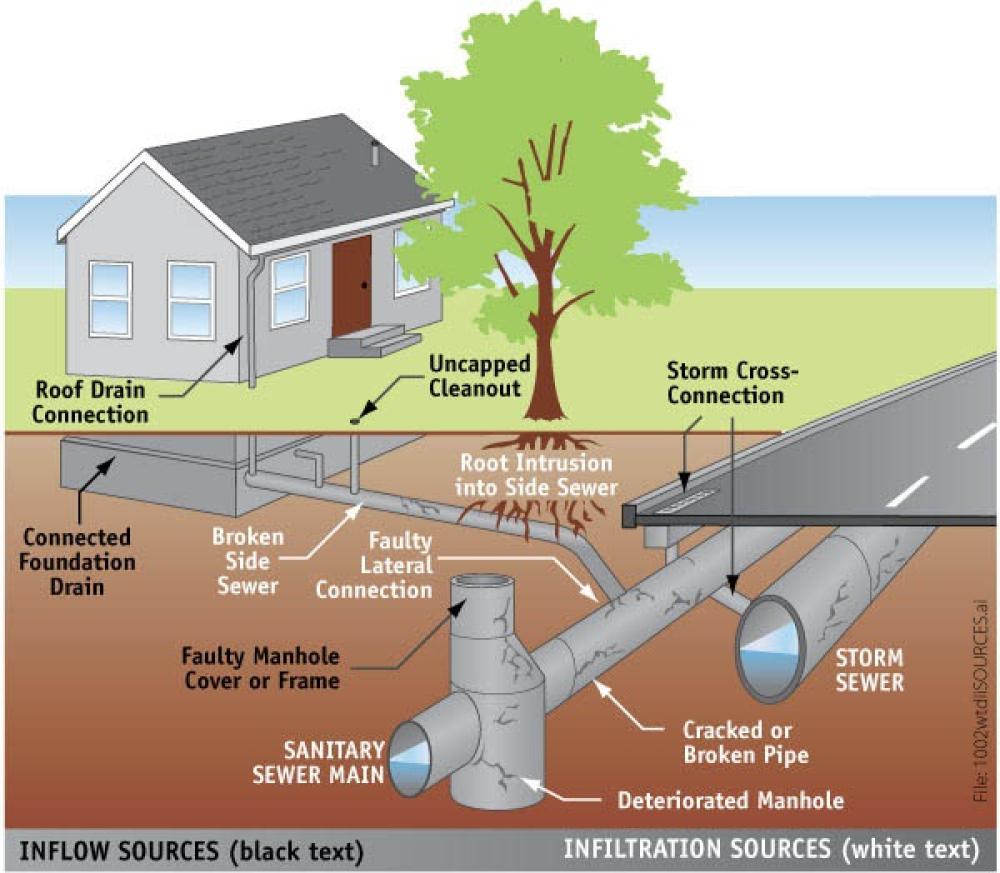
Inflow and Infiltration
Inflow and infiltration (I&I) are terms used to describe two different types of water that can enter a sewer system or wastewater treatment plant. Both of these types of water can cause problems in the system and it is important to understand the difference between them and the ways we can keep them out of our sewers and treatment plant.
Inflow
Inflow refers to water that enters the sewer system from above ground sources such as rainwater or snowmelt. This can happen when there are cracks or holes in the pipes or manholes, which allows the water to enter. Inflow can also occur when storm water drains are connected to the sewer system. Inflow can overload the sewer utility system and cause backups or overflows.
Infiltration
Infiltration refers to water that enters the sewer system from below the ground such as groundwater and subsurface flow. This can happen when there are cracks, holes or gaps in the pipes, or when the surrounding soil is saturated due to heavy rain. Infiltration can cause the sewer system to become overloaded and can contribute to our treatment plant receiving more water that it was designed to handle.
Describe Kimberley's sewer system.
The City of Kimberley has a separated sewer made up of two sewer systems:
- Sanitary Sewer: designed to carry sewage to facilities that treat water before returning it to the environment.
- Storm Sewer: prevents streets from flooding by draining and carrying excess stormwater (from rainfall and snowmelt) to nearby rivers.
Why is I&I a problem?
Inflow and infiltration are problems because they:
- Reduce the capacity of the sewage system leaving less for existing residents and future growth
- Make sewage treatment less efficient since the sewage is diluted by water
- Increase the cost of water to residents because sewage treatment plants are required to treat a higher flow volume
- May cause sewage overflows or overwhelm treatment plants leading to health risks and property and environmental damage.
While rare, sanitary sewer overflows have occurred from the system during extreme rainfall events. The risk of future overflows is lowered as I&I are reduced.
How can we fix I&I?
To date, the City has focused efforts on strategically addressing I&I in owned infrastructure. However, I&I can be difficult to manage since 70% can originate on private property. Homeowners can help reduce I&I too:
- Know where your sewer lateral is on your property
- Avoid planting trees and shrubs over sewer laterals as roots seek water and can damage sewer pipes
- Check your gutters and drains to ensure they are not connected to the sanitary sewer system.
- Disconnect roof downspouts from the sanitary sewer system. Even better, install a rain barrel under your roof leader, if conditions permit
- Disconnect foundation drains and groundwater sump pumps from the sanitary sewer system
- Have your property's sewer lateral inspected. Replace any known broken, leaky or problem sections of your property's sewer lateral. Maintaining and repairing the lateral is the homeowner's responsibility and can reduce I&I and prevent sewer backups into your home.
